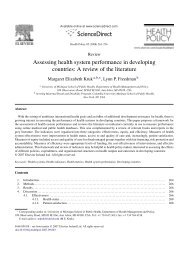Part II Community-Based Forest Management Program - ppmrn
Part II Community-Based Forest Management Program - ppmrn
Part II Community-Based Forest Management Program - ppmrn
Create successful ePaper yourself
Turn your PDF publications into a flip-book with our unique Google optimized e-Paper software.
EXECUTIVE SUMMARY<br />
• POs in all seven projects covered were not able to uplift their socio<br />
economic condition and manage forest resources as illustrated below:<br />
‣ Except in the case of PMRSP, majority of livelihood projects identified<br />
and implemented during <strong>Community</strong> Organizing (CO) stage were either<br />
suspended or terminated due to the absence of market for the products,<br />
unavailability or high cost of needed inputs and unsuitable climate. The<br />
failure of livelihood projects can be attributed to inadequate trainings and<br />
feasibility studies.<br />
‣ About 47% of household population within PWRS area were non PO<br />
members and yet, the entire area was awarded to the PO. This hinders the<br />
development of the area particularly those occupied by non-PO members.<br />
‣ Protection activities were not effectively carried out despite requirements<br />
under the CBFMA. Thus, survival rates attained during CSD<br />
implementation were not sustained and forest fires were not prevented or<br />
contained destroying at least 50 and 423 hectares of the established<br />
plantations within the PWRS and DWSP coverage, respectively.<br />
• Policies, procedures and regulations were not effectively implemented<br />
in the following instances:<br />
‣ Project appraisals of DWSP, STAGBAK MRSP and PWRSP were not<br />
thoroughly undertaken. In the case of DWSP, project area contained<br />
mineral deposit which resulted in abnormal/stunted growth of planted<br />
trees within reforestation area and subsequent destruction of affected<br />
portion due to mining activities. On the other hand, at STAGBAK MRSP<br />
and PWRSP, project areas included areas unsuitable for reforestation and<br />
with existing land claims. This adversely affected the smooth<br />
implementation of CSD activities and the survival rates of the established<br />
plantation which were found to be as low as 35.75% and 61.88%,<br />
respectively, as of November 2005 despite massive replanting activities.<br />
‣ The land use plan defined in the Feasibility Study of PWRS was not<br />
strictly observed resulting in increased estimated soil erosion from<br />
303,455 to 390,898.39 tons/year. A portion of the area intended for<br />
Assisted Natural Regeneration (ANR) with estimated minimal soil erosion<br />
was converted into agro-silvipastural plantation with estimated higher<br />
average erosion. Moreover, inappropriate upland cultivation which<br />
promotes soil erosion is widely practiced within the CBFMA area.<br />
‣ The PO in DWSP was still awarded maintenance and protection contracts<br />
during CBFMA period. Under the CBFMA, POs are obliged to maintain<br />
the CBFMA area at their own expense.<br />
• Inadequate coordination with other government agencies resulted in the<br />
granting of mining permit within the DWSP areas to another PO and<br />
improper maintenance of infrastructure projects turned-over to LGUs;<br />
5





